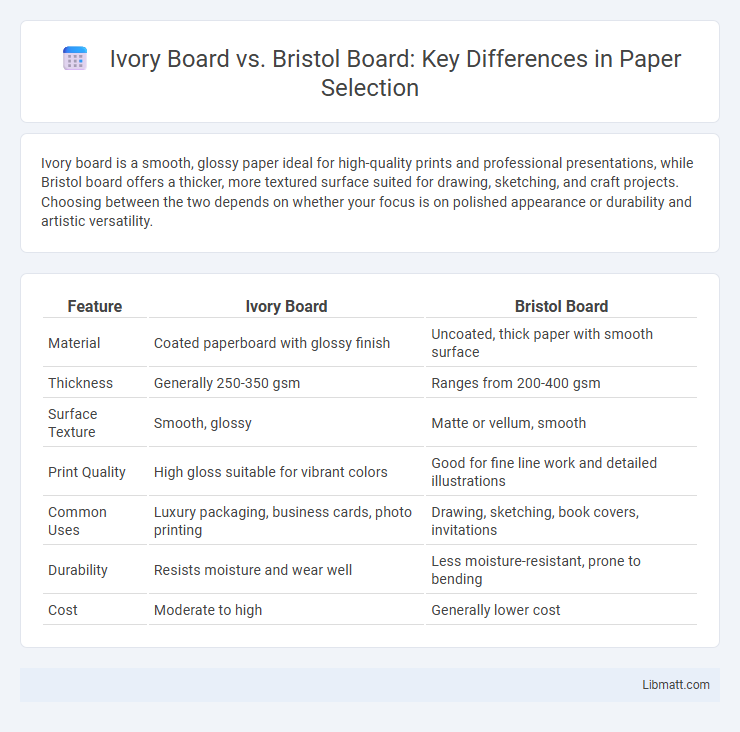Ivory board is a smooth, glossy paper ideal for high-quality prints and professional presentations, while Bristol board offers a thicker, more textured surface suited for drawing, sketching, and craft projects. Choosing between the two depends on whether your focus is on polished appearance or durability and artistic versatility.
Table of Comparison
| Feature | Ivory Board | Bristol Board |
|---|---|---|
| Material | Coated paperboard with glossy finish | Uncoated, thick paper with smooth surface |
| Thickness | Generally 250-350 gsm | Ranges from 200-400 gsm |
| Surface Texture | Smooth, glossy | Matte or vellum, smooth |
| Print Quality | High gloss suitable for vibrant colors | Good for fine line work and detailed illustrations |
| Common Uses | Luxury packaging, business cards, photo printing | Drawing, sketching, book covers, invitations |
| Durability | Resists moisture and wear well | Less moisture-resistant, prone to bending |
| Cost | Moderate to high | Generally lower cost |
Introduction to Ivory Board and Bristol Board
Ivory board is a premium quality, thick paper known for its smooth, glossy finish, commonly used for high-end packaging, luxury invitations, and artistic prints. Bristol board, typically made from heavy paper stock, features a smooth or vellum surface and is favored for detailed drawings, comics, and crafting due to its durability and ability to hold ink or paint well. Both boards offer unique textures and weights, catering to different creative and professional applications based on the desired appearance and functionality.
Key Differences Between Ivory Board and Bristol Board
Ivory board features a smooth, glossy finish primarily used for high-end packaging and luxury print materials, while Bristol board offers a thicker, more rigid surface ideal for detailed illustration and graphic arts. The key difference lies in texture and weight; ivory board is typically coated and less absorbent, enhancing color vibrancy, whereas Bristol board is uncoated and designed to handle various mediums like ink, pencil, and watercolor. Your choice between these boards should consider the project's need for durability, print quality, and artistic technique.
Composition and Material Properties
Ivory board features a smooth, high-quality paper surface made from cellulose fibers with a clay coating that provides a satin finish, making it ideal for printing and packaging. Bristol board consists of multiple layers of compressed paper pulp, resulting in a thick, rigid, and durable paper with a smooth surface, often used for illustration and technical drawings. Your choice depends on whether you need the glossy, refined texture of ivory board or the sturdy, matte finish of bristol board for your project.
Surface Texture and Finish Comparison
Ivory board features a smooth, satin surface with a subtle sheen, ideal for projects requiring a polished, professional look. Bristol board offers a variety of finishes, including smooth and vellum surfaces, where smooth Bristol provides a flat, even texture suited for detailed pen work, and vellum Bristol has a slightly toothy feel that enhances grip for pencil and charcoal. Both boards differ in their tactile qualities, influencing suitability for specific artistic techniques and mediums.
Thickness and Weight Variations
Ivory board typically ranges from 270 to 350 gsm, providing a smooth, satin finish ideal for luxury packaging and high-end print materials. Bristol board, available in thicknesses from 200 to 500 gsm, offers a robust, rigid surface favored for illustration and card-making projects. Both boards vary in weight and thickness, with bristol board generally thicker and heavier, offering superior durability over ivory board for structural applications.
Printability and Ink Absorption
Ivory board features a smooth, slightly coated surface that enhances printability by delivering sharp, vibrant images with minimal ink bleeding, making it ideal for high-quality digital and offset printing. Bristol board, known for its dense, absorbent texture, offers superior ink absorption, which helps prevent smudging and is perfect for detailed drawing and ink-based artwork. When choosing between the two, consider how Your project benefits from either the crisp print finish of ivory board or the rich ink absorption of bristol board.
Uses in Art, Printing, and Packaging
Ivory board is favored in packaging and high-quality printing for its rigid, glossy surface that enhances visual appeal and durability, making it ideal for luxury product boxes and postcards. Bristol board excels in art applications such as drawing, illustration, and watercolor due to its smooth, heavyweight texture that supports various media without warping or bleed-through. In printing, Bristol board offers a matte finish suited for detailed line work and graphic prints, whereas ivory board's coated surface provides vibrant color reproduction and stiffness essential for upscale packaging solutions.
Durability and Longevity
Ivory board offers a smooth, coated surface that resists smudging and retains print quality over time, making it highly durable for presentations and packaging. Bristol board, known for its thickness and stiffness, provides strong structural integrity ideal for heavier drawing media and long-term artwork. Your choice depends on whether you prioritize print longevity with ivory board or robust physical durability with bristol board.
Cost and Availability Considerations
Ivory board typically costs more due to its premium finish and is less widely available than Bristol board, which is often more affordable and easier to find in art supply stores. Your choice may depend on budget constraints and the accessibility of specific board types in your local market. Both boards come in various weights and sizes, but Bristol board offers a broader range for different project needs at competitive prices.
Choosing the Right Board for Your Project
Ivory board and Bristol board differ in texture, weight, and finish, affecting their suitability for various art and craft projects. Ivory board features a smooth, coated surface ideal for high-quality prints and professional presentations, while Bristol board offers a thicker, more rigid structure favored for detailed illustrations and mixed media work. Selecting the right board depends on your project's requirements, such as the desired finish, durability, and compatibility with media like ink, markers, or paint.
ivory board vs bristol board Infographic

 libmatt.com
libmatt.com